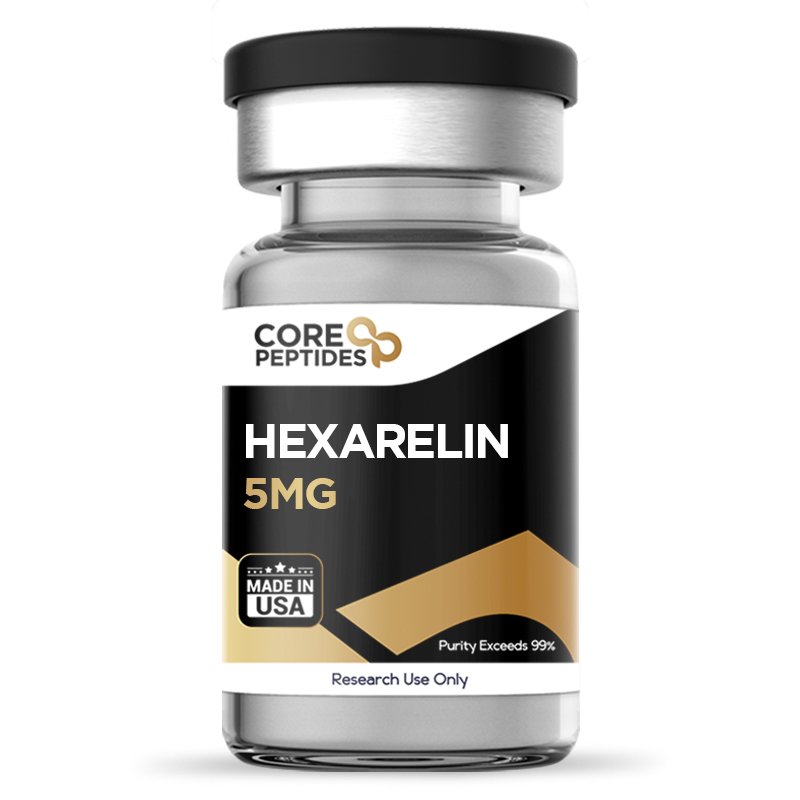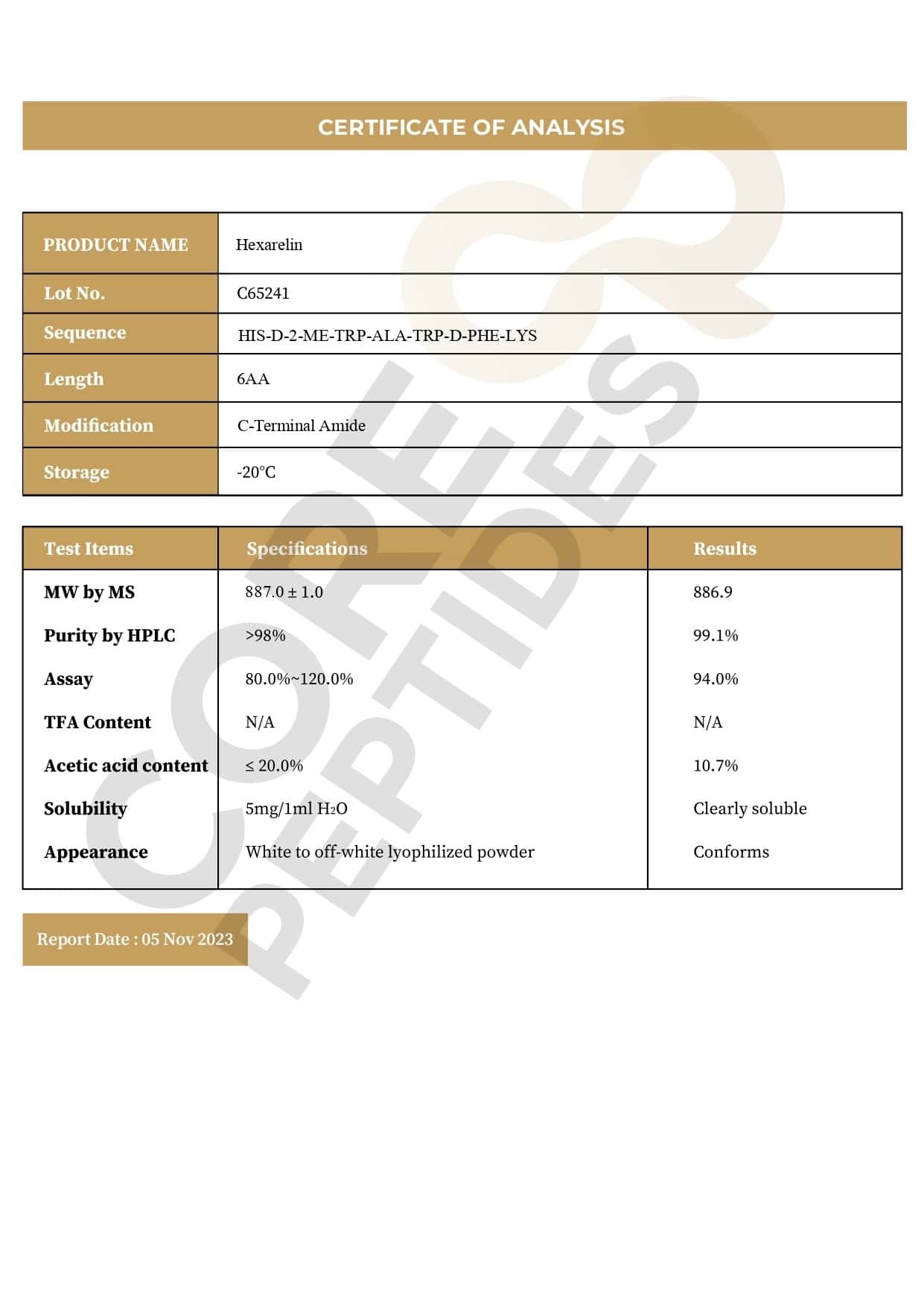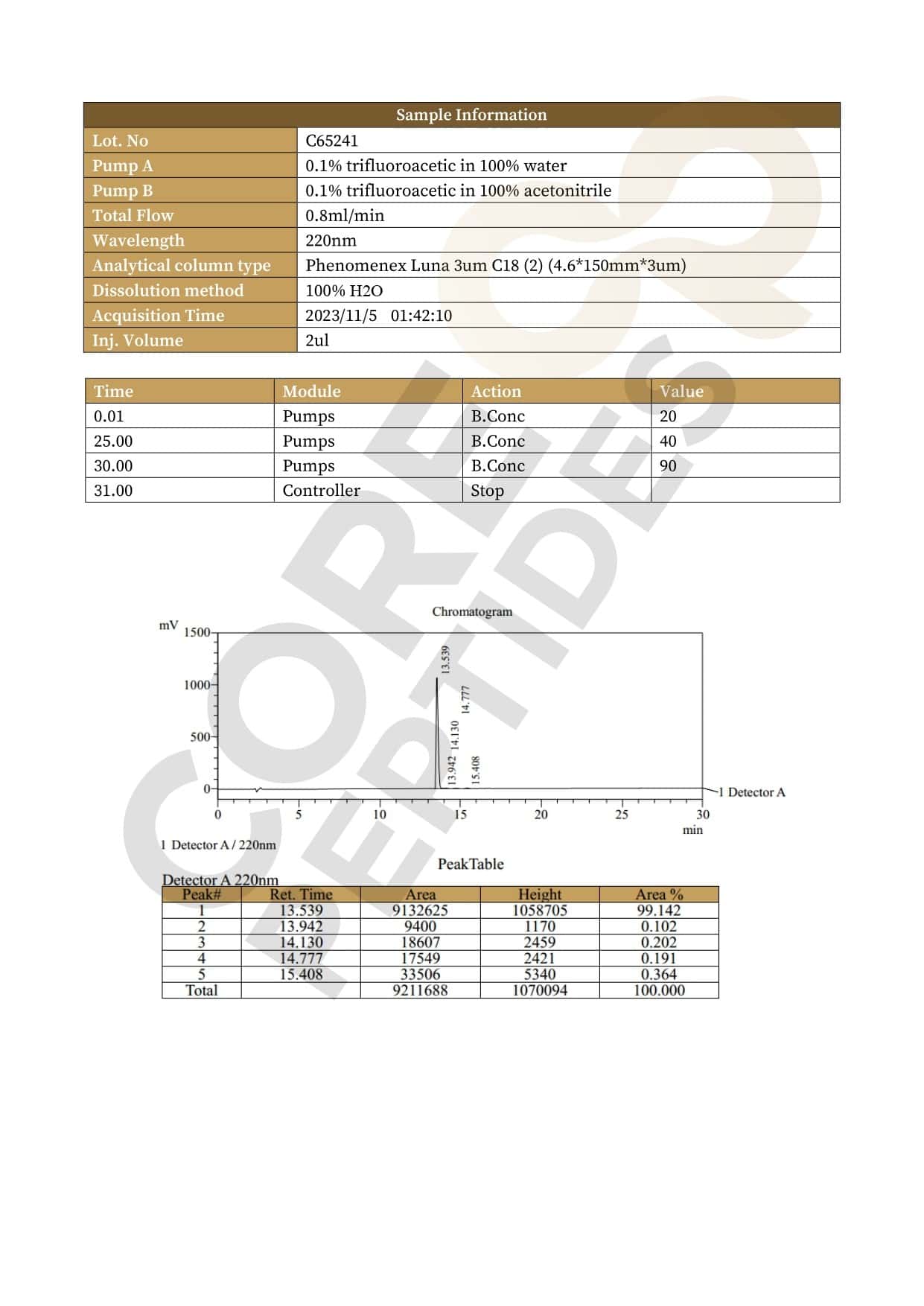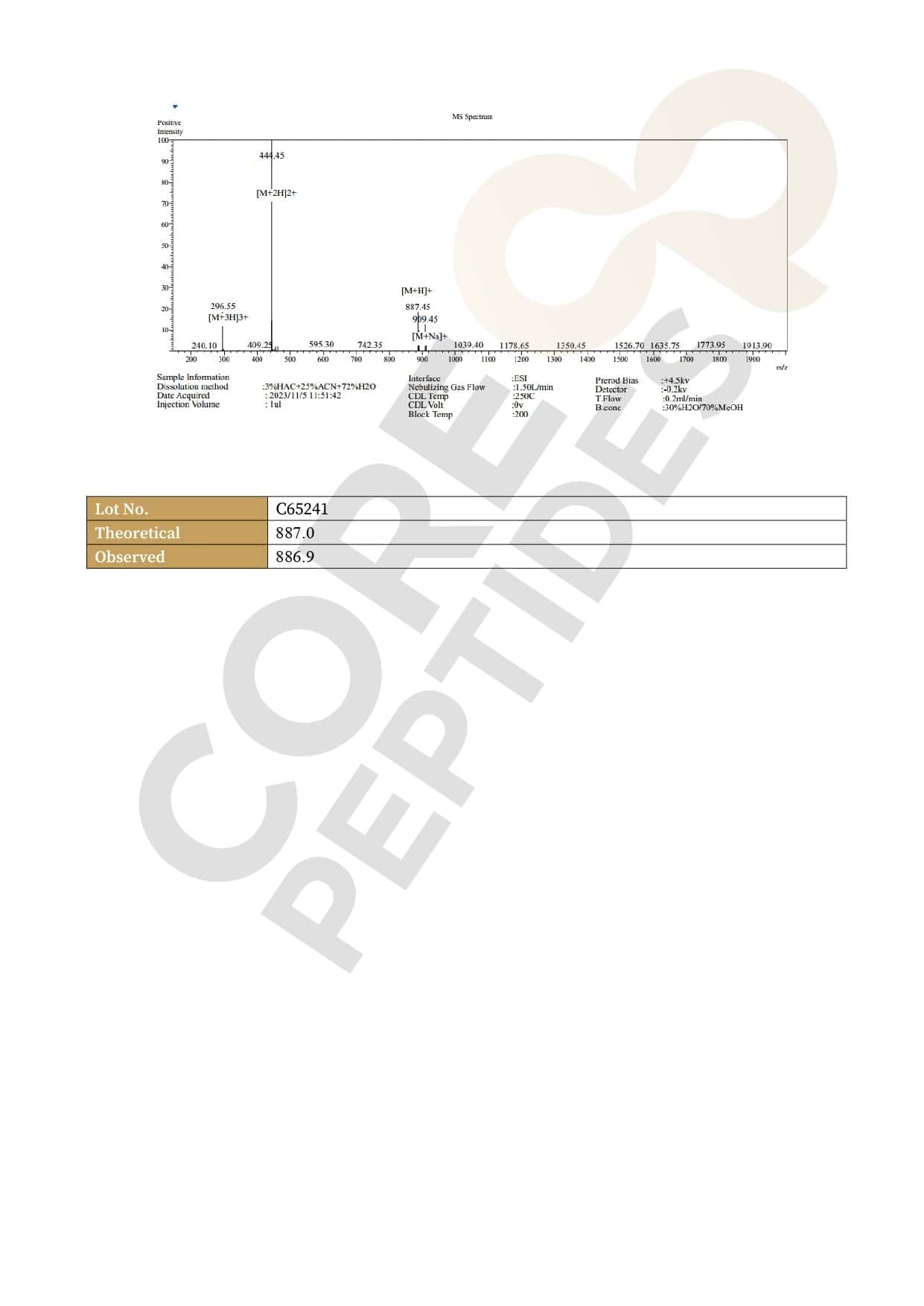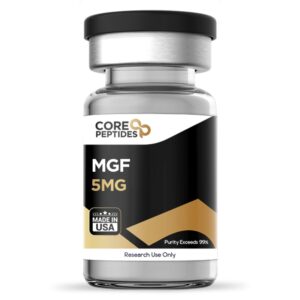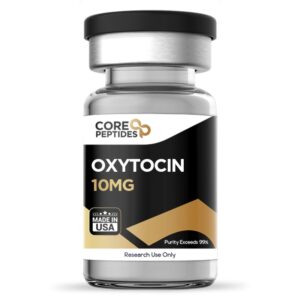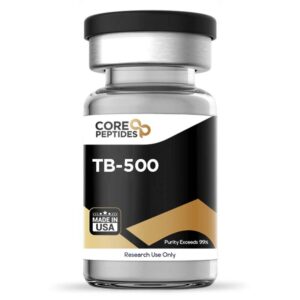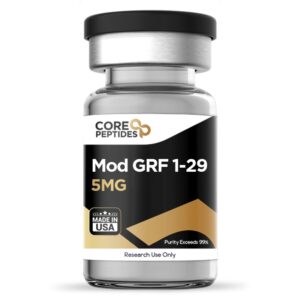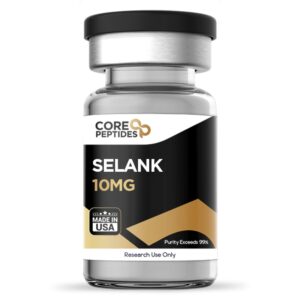Hexarelin (5mg)
$44.00
Size: 5mg
Contents: Hexarelin (5mg)
Form: Lyophilized powder
Purity: >99%
SKU: P-HEXARELIN-5
FREE Shipping on $200+ orders
FREE Bacteriostatic Water (30ml) on $200+ orders
Discount per Quantity
| Quantity | Discount | Price |
|---|---|---|
| 5 - 8 | 5% | $41.80 |
| 9 + | 10% | $39.60 |
Hexarelin Peptide
Hexarelin is a growth hormone-releasing peptide (GHRP) that researchers consider may host a potential action parallel tothat of peptide GHRP-6.(1) Hexarelin, or Examorelin, is a synthetic peptide composed of six amino acids.(2) Regarding its mechanism of action, Hexarelin is believed to work by mimicking the naturally occurring peptide ghrelin, which contains 28 amino acids and is considered by scientists to stimulate the release of growth hormone (GH) and induce hunger. Several synthetic compounds, including Hexarelin, which appears to exhibit actions similar to those of ghrelin, were developed more than 25 years ago.(3) Since their development, continuous studies and research have been conducted to fully examine the actions and potential of these peptides.
Overview
Hexarelin is hypothesized to operate by imitating ghrelin's role in activating ghrelin receptors throughout the organism, notably those within the pituitary gland and hypothalamus. Known as growth hormone secretagogue receptors (GHS-Rs), more specifically the GHSR-1a, their stimulation may lead to the secretion of GH, positioning Hexarelin as a potential growth hormone secretagogue (GHS). This appears to be an alternative mechanism regulating the synthesis of GH by the anterior pituitary cells, compared to the direct stimulation of the hypothalamus via the native growth hormone-releasing hormone (GHRH).
The GHSR-1a is found on the hypothalamus and pituitary gland and across various parts of the nervous system and other tissues. Thus, Hexarelin's action is posited to encompass both direct and indirect triggers of GH release, potentially impacting GHS-Rs in the pituitary and indirectly affecting the hypothalamus.(4) When Hexarelin engages GHS-Rs, it is hypothesized that it might cause a structural change, possibly activating intracellular signaling pathways that largely depend on G-proteins, such as the potential activation of protein kinase C (PKC), possibly amplifying the signaling pathway and facilitating GH release from pituitary cells. However, exposure to Hexarelin has also been posited to lead to transient receptor desensitization that may last for days or weeks.(5)
Furthermore, Hexarelin has been posited to be unselective towards the apparent synthesis of GH, and researchers suggest the peptide may also induce the production of other pituitary hormones. Namely, these hormones may include the adrenocorticotropic hormone (ACTH) and prolactin.(6) In general, the upregulation of these hormones in experimental settings is undesired by researchers.
Researchers note that Hexarelin's potential to activate GHS-Rs also in other nervous system areas might initiate cellular processes that increase the production of hunger-related neuropeptides, such as Neuropeptide Y (NPY) and Agouti-related peptide (AgRP). These are considered critical in managing energy balance and appetite control. Concurrently, Hexarelin might also reduce the secretion of the appetite-suppressing hormone, melanocyte-stimulating hormone (α-MSH), thus tipping the balance towards increased hunger and encouraging food intake. Hexarelin may also influence the mesolimbic reward system, associated with craving regulation for flavorful food, through potential GHSR-1a activation. This could theoretically amplify the motivation for eating, possibly by activating cyclic adenosine monophosphate (cAMP) pathways, thereby suggesting Hexarelin's potential role in altering feeding behavior and reward-driven eating practices.(7)
Chemical Makeup
Molecular Formula: C47H58N12O6
Molecular Weight: 887.06 g/mol
Other Known Titles: examorelin
Research and Clinical Studies
Hexarelin Peptide and Growth Hormone Release
A study(8) was conducted on three groups of research models at the adolescent, maturation, and elderly stages of development to evaluate the GH-releasing potential of the peptide. All models were presented with Hexarelin, GHRH alone, or GHRH combined with arginine. In adolescent models, the GH levels were reportedly elevated by GHRH + arginine combination, while GH levels did not appear to be raised by Hexarelin alone. On the other hand, Hexarelin appeared to induce higher GH levels than the increased GH levels induced by GHRH alone and GHRH + arginine combination in adolescent and mature models. In elderly models, Hexarelin reportedly induced higher GH levels in comparison to GHRH. However, the GH levels were reportedly lower than GHRH + arginine combination. These results suggest that Hexarelin may potentially elevate GH levels in adolescent and mature models. While it might increase GH levels in the elderly and adolescent groups, no significant effects were reported.
Hexarelin Peptide and Potential GHRH Synergism
The main aim of this study(9) was to determine the potential of Hexarelin on the GH1 murine tumor cell line, which may be insensitive towards GHRH. Furthermore, this study monitored the potential involvement of GHRH in the possible action of Hexarelin on the GH1 murine tumor cells. Hexarelin was presented in normal control murine pituitary cells and GH1 murine cells. Researchers reported that GHRH appeared to increase GH levels in the control rat cells without presenting any apparent effects on GH1 cells. Moreover, when presented with Hexarelin, GHRH appeared to cause no impact on GH release. These results suggest that GHRPs and GHRHs may act on two distinct sites, and GHRPs, such as Hexarelin, may have the potential to act on cells that are not sensitive to GHRH effects. Most importantly, the researchers commented, "In this latter cell model, GHRH and Hexarelin were [posited] to have additive stimulatory effects on GH secretion.” Thus, it may be suggested that due to the distinct pathways of GH-stimulation by Hexarelin and GHRH, they may have complementary action on the GH synthesis and potentially result in greater stimulation than either agent alone.
Hexarelin Peptide and Cardiovascular Activity
Studies(10) have suggested that the acute presentation of Hexarelin may induce positive inotropic activity in the cardiovascular system. When presented to research models, the peptide reportedly increased the left ventricular ejection fraction (LVEF), possibly without affecting blood pressure. When presented to research models of disrupted coronary artery flow, the Hexarelin reportedly exhibited the potential to increase cardiac output and arterial pressure without changing heart rate. Furthermore, when presented in ischemic rat hearts, Hexarelin appeared to have restored the electrophysiological properties of the heart cells, and inhibited cell apoptosis, thereby producing positive inotropic activity and potentially promoting heart cell survival.(11)
Another study(12) was conducted in which Hexarelin was presented daily to murine heart cells that were experimentally induced to undergo myocardial infarction. The results suggested that the peptide had the potential to increase stroke volume and cardiac output while decreasing peripheral resistance.
Hexarelin Peptide and Composition
One study(13) aimed to determine the possible fluctuation of sex-based weight composition with the growth hormone-releasing potential of Hexarelin. This study evaluated the impact of Hexarelin exposure, and upon analyzing the test samples, researchers suggested that the stimulus of Hexarelin and the consequent peak growth hormone release appeared to be negatively correlated to fat mass. Increased fat mass may lead to a reduction in GH release following Hexarelin exposure. Gender reportedly exhibited no significant impact on GH release.
Hexarelin Peptide and Muscle Tissue
Preliminary experiments suggest that Hexarelin may have sparing effects on muscle tissue in research models exposed to catabolic conditions. Several such experiments have reported an apparent reduction in muscle mass loss and muscle strength loss, potentially due to the action of Hexarelin. For example, one of the studies suggested that a group of research models exposed to catabolic agents lost 12% muscle mass. In comparison, the addition of Hexarelin may have lowered that loss to 7%.(14) A similar experiment also commented that the peptide may have attenuated the reduction in strength levels associated with exposure to catabolic agents.(15)
Hexarelin peptide is available for research and laboratory purposes only. Please review and adhere to our Terms and Conditions before ordering.
References:
- Giustina A, Bonfanti C, Licini M, Ragni G, Stefana B. Hexarelin, a novel GHRP-6 analog, stimulates growth hormone (GH) release in a GH-secreting rat cell line (GH1) insensitive to GH-releasing hormone. Regul Pept. 1997 May 14;70(1):49-54. https://pubmed.ncbi.nlm.nih.gov/9250581/
- National Center for Biotechnology Information (2021). PubChem Compound Summary for CID 6918297, Examorelin. Retrieved August 19, 2021 from https://pubchem.ncbi.nlm.nih.gov/compound/Examorelin
- Fabio Broglio et al, Ghrelin: Much more than a natural growth hormone secretagogue. Division of Endocrinology and Metabolism, Department of Internal Medicine; Division of Pathological Anatomy, Department of Biomedical Sciences and Oncology https://www.ima.org.il/FilesUploadPublic/IMAJ/0/56/28152.pdf
- Torsello A, Grilli R, Luoni M, Guidi M, Ghigo MC, Wehrenberg WB, Deghenghi R, Müller EE, Locatelli V. Mechanism of action of Hexarelin. I. Growth hormone-releasing activity in the rat. Eur J Endocrinol. 1996 Oct;135(4):481-8. https://pubmed.ncbi.nlm.nih.gov/8921832/
- Rahim, A., O'Neill, P. A., & Shalet, S. M. (1998). Growth hormone status during long-term hexarelin therapy. The Journal of clinical endocrinology and metabolism, 83(5), 1644–1649. https://doi.org/10.1210/jcem.83.5.4812
- Massoud, A. F., Hindmarsh, P. C., & Brook, C. G. (1996). Hexarelin-induced growth hormone, cortisol, and prolactin release: a dose-response study. The Journal of clinical endocrinology and metabolism, 81(12), 4338–4341. https://doi.org/10.1210/jcem.81.12.8954038
- Bresciani, E., Pitsikas, N., Tamiazzo, L., Luoni, M., Bulgarelli, I., Cocchi, D., Locatelli, V., & Torsello, A. (2008). Feeding behavior during long-term hexarelin administration in young and old rats. Journal of endocrinological investigation, 31(7), 647–652. https://doi.org/10.1007/BF03345618
- Bellone J, Bartolotta E, Sgattoni C, Aimaretti G, Arvat E, Bellone S, Deghenghi R, Ghigo E. Hexarelin, a synthetic GH-releasing peptide, is a powerful stimulus of GH secretion in pubertal children and in adults but not in prepubertal children and in elderly subjects. J Endocrinol Invest. 1998 Sep;21(8):494-500. https://pubmed.ncbi.nlm.nih.gov/9801989/
- Giustina A, Bonfanti C, Licini M, Ragni G, Stefana B. Hexarelin, a novel GHRP-6 analog, stimulates growth hormone (GH) release in a GH-secreting rat cell line (GH1) insensitive to GH-releasing hormone. Regul Pept. 1997 May 14;70(1):49-54. https://pubmed.ncbi.nlm.nih.gov/9250581/
- Mao, Yuanjie et al. “The cardiovascular action of hexarelin.” Journal of geriatric cardiology : JGC vol. 11,3 (2014): 253-8. https://www.ncbi.nlm.nih.gov/pmc/articles/PMC4178518/
- Ma Y, Zhang L, Edwards JN, Launikonis BS, Chen C. Growth hormone secretagogues protect mouse cardiomyocytes from in vitro ischemia/reperfusion injury through regulation of intracellular calcium. PLoS One. 2012;7(4):e35265. https://pubmed.ncbi.nlm.nih.gov/22493744/
- Tivesten A, Bollano E, Caidahl K, Kujacic V, Sun XY, Hedner T, Hjalmarson A, Bengtsson BA, Isgaard J. The growth hormone secretagogue hexarelin improves cardiac function in rats after experimental myocardial infarction. Endocrinology. 2000 Jan;141(1):60-6. https://pubmed.ncbi.nlm.nih.gov/10614623/
- Rahim A, O'Neill P, Shalet SM. The effect of body composition on hexarelin-induced growth hormone release in normal elderly subjects. Clin Endocrinol (Oxf). 1998 Nov;49(5):659-64. https://pubmed.ncbi.nlm.nih.gov/10197083/
- Bresciani, E., Rizzi, L., Molteni, L., Ravelli, M., Liantonio, A., Ben Haj Salah, K., Fehrentz, J. A., Martinez, J., Omeljaniuk, R. J., Biagini, G., Locatelli, V., & Torsello, A. (2017). JMV2894, a novel growth hormone secretagogue, accelerates body mass recovery in an experimental model of cachexia. Endocrine, 58(1), 106–114. https://doi.org/10.1007/s12020-016-1184-2
- Conte, E., Camerino, G. M., Mele, A., De Bellis, M., Pierno, S., Rana, F., Fonzino, A., Caloiero, R., Rizzi, L., Bresciani, E., Ben Haj Salah, K., Fehrentz, J. A., Martinez, J., Giustino, A., Mariggiò, M. A., Coluccia, M., Tricarico, D., Lograno, M. D., De Luca, A., Torsello, A., … Liantonio, A. (2017). Growth hormone secretagogues prevent dysregulation of skeletal muscle calcium homeostasis in a rat model of cisplatin-induced cachexia. Journal of cachexia, sarcopenia and muscle, 8(3), 386–404. https://doi.org/10.1002/jcsm.12185

